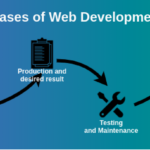
In the world of creating websites, the terms “web design” and “web development” are often used interchangeably, but they refer to distinct aspects of the process. Understanding the difference between the two can help businesses make informed decisions when hiring professionals for their projects. Here’s what you need to know about web design and web development.
1. Definition and Focus
- Web Design: This refers to the visual and aesthetic aspects of a website. Web designers are responsible for creating the layout, color schemes, typography, and overall look and feel of a site. Their goal is to ensure that the website is visually appealing, user-friendly, and aligned with the brand identity.
- Web Development: This involves the technical implementation and functionality of a website. Web developers are responsible for writing the code that makes a website work, ensuring that it functions properly and integrates with various technologies. Development can be divided into two main areas: front-end (client-side) and back-end (server-side).
2. Key Responsibilities
- Web Designers:
- Create wireframes and prototypes to visualize website layouts.
- Design user interfaces (UI) and user experiences (UX) that enhance usability.
- Select color palettes, fonts, and images that align with the brand.
- Ensure responsive design for compatibility across devices.
- Web Developers:
- Write code using languages such as HTML, CSS, JavaScript (front-end) and PHP, Python, Ruby (back-end).
- Implement content management systems (CMS) like WordPress, Joomla, or Drupal.
- Manage databases and server configurations to ensure smooth operation.
- Optimize website performance, security, and scalability.
3. Skills Required
- Web Design Skills:
- Proficiency in graphic design tools (e.g., Adobe Photoshop, Sketch, Figma).
- Understanding of design principles, color theory, and typography.
- Knowledge of responsive design and usability best practices.
- Familiarity with HTML and CSS for basic coding and layout adjustments.
- Web Development Skills:
- Strong programming skills in various coding languages (HTML, CSS, JavaScript, etc.).
- Understanding of databases and server management.
- Familiarity with version control systems (e.g., Git).
- Knowledge of web hosting and domain management.
4. Collaboration Between Designers and Developers
Effective web design and development require collaboration between both roles. Designers provide the vision and user experience, while developers bring that vision to life through code. Regular communication ensures that the design is not only aesthetically pleasing but also functional and efficient.
5. Career Paths
- Web Designer: Typically has a background in graphic design, visual arts, or user experience. Designers often focus on creating compelling and intuitive interfaces.
- Web Developer: Often has a background in computer science, software engineering, or information technology. Developers focus on the technical aspects of building and maintaining websites.
Conclusion
While web design and web development are closely related, they encompass different skill sets and responsibilities. Understanding these differences is crucial for businesses looking to create a successful online presence. By recognizing the unique contributions of designers and developers, you can better plan your website project and ensure a harmonious collaboration that leads to an effective and engaging website.






